Fascinating proteins: #ATPsynthase
Greetings Steemit!
I would like to introduce you to a fascinating protein, ATP synthase, the power plant of our cells, working its machinery in the membranes of our mitochondria. It´s 3D structure and individual parts, or subunits as we call them in biochemistry, makes it so similar to a nano scale rotary engine and it's even driven by an difference in electric potential!
If you only know the function and/or structure of one protein, let it be ATP synthase.
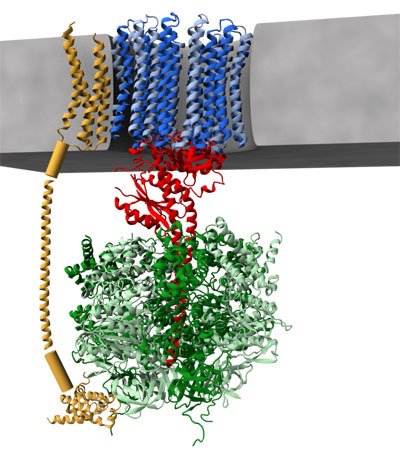
It is abundant in every cell of our body producing Adenosine triphosphate, ATP, the energy currency of our cells. It is estimated that a 70kg person goes through at least over half his/here's body weight or 35 kg, if not the entire wight in ATP every Day! Every single one of the trillions of our cells contain this protein and perform the reaction of ATP synthesis, showing that ATP synthase is extremely important for cellular life. Without ATP, many cellular reactions would cease instantly and the cells life would come to a halt, or simply starve one could say. Without further ado, here is:
The ATP synthase
This protein is very old evolutionary speaking, even older than the mechanisms of photosynthesis and its structure has been intact or highly conserved as it is called, during all of evolution. The structure itself is simply one of the best nature has to offer and every biochemist on earth has read about it.
It is fast as well, it is estimated that each one out of our trillion of cells do this reaction a million times every minute, mind blowing!
ATP synthase has two different domains, one integrated in the membrane, the grey area, called the F0 subunit and one intra-mitochondrial domain, called the F1 subunit. This structure, having contact with both sides of the membrane, is very important for its activity, since the membrane allows for a potential gradient to build.
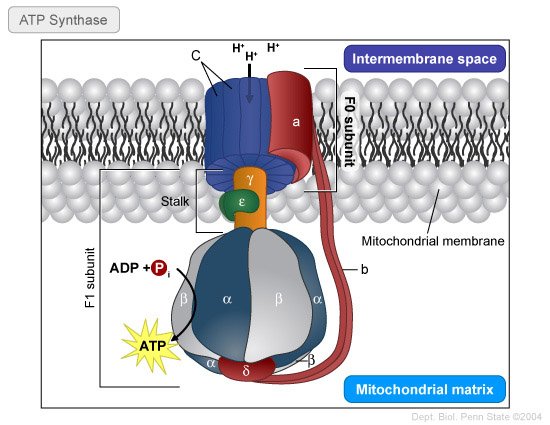 >
>
ATP synthase works with two motors, first the cylindrical, upper motor located in the F0 subunit is driven by hydrogen flow into the mitochondria, so a difference in concentration of hydrogen inside and outside the membrane is needed. The high concentration of hydrogen outside of the membrane is a result of our metabolism and essentially, food is broken down and used to pump hydrogen over the membrane.
When the F0 unit rotates, it gives rotational energy to the central axis, which is connected to the F1 unit. This forces the lower motor in the F1 to also rotate, working as a energy generator in this case.
When the lower motor turns it smashes ADP, adenosine di-phosphate together with phosphate by bringing the molecules close and inducing a phosphate-phosphate bond. The result is ATP, the energy currency needed by all our cells.
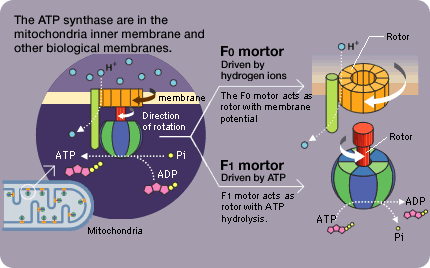
The F0 subunit also contain an in channel for hydrogen which leads it to the binding site of the motor. This unit called unit a, in red the first pircure and is essentially a pump. After a full rotation in the motor, there is also an exit channel, bringing hydrogen back into the mitochondria and thereby using this electrical gradient as gas. The used hydrogen is turned into water as a result. The complete reaction looks simple but is thermodynamicly un favored, meaning it would never happen naturally, without the hydrogen gradient and this complex protein.
As if it was not enough, it can off course use the bottom engine to rotate to top part and pump hydrogen directly out of the cell, by cleaving ATP to ADP + phosphate, should it need to! This is simply an emergency response to high hydrogen levels.
There are many nice animations of the protein in action,i think it's an amazing show, see for your self!
Animation of ATP synthase in action, Youtube
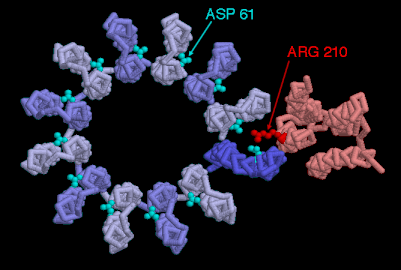
The binding of phosphate to ADP is dependent on 3 steps in the F1 unit which equals a total of roughly 120 degrees rotation, of a possible 360 degree, from the top rotor in F0. In other words it needs 1 / 3 rotations from the top engine to get 1 full rotation in the bottom generator, to produce 1 ATP. This off course, equals to 4 hydrogens if there are 12 binding spots, 12/3 = 4 rite ?Almost, known species contain 10-14 binding spots so the numbers tend to differ just a bit between between them.
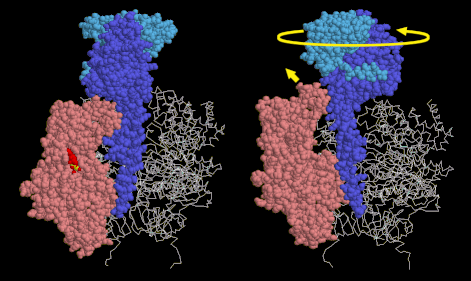
This truly is a amazing little nano machinery working hard four our survival all day long and I hope you found the protein interesting.
The last two pictures originate from The Protein Data Base, my favorite homepage striving to list all known protein structures with 3D coordinates, images and loads of information, try it out!
->Visit the protein data base <-
->ATPsynthase @ The Protein data base <-
->Again, dont miss the animation of this beast in action <-
Nice. Followed. Resteemed. Upvoted
Thanks, nice of you :)
https://www.clixsense.com/?12315177
https://www.neobux.com/?r=jfe323
have a nice day
please dont forget vote and follow :D
Great worrkk
Thanks :)
@OriginalWorks
The @OriginalWorks bot has determined this post by @clausewitz to be original material and upvoted it!
To call @OriginalWorks, simply reply to any post with @originalworks or !originalworks in your message!
Congratulations @clausewitz! You have completed some achievement on Steemit and have been rewarded with new badge(s) :
Click on any badge to view your own Board of Honor on SteemitBoard.
For more information about SteemitBoard, click here
If you no longer want to receive notifications, reply to this comment with the word
STOP